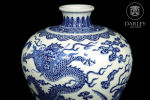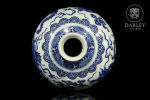FIRST SESSION | LIVE AUCTION 20TH DECEMBER
"ASIAN ART"
LOTS 1 - 180
1:00 PM (Valencia, España)
Jade, ceramics and porcelain. Decorative arts. Sculpture and painting.
PREFERRED LOT
50 - A fine and rare blue and white "Dragon" meiping, Qing dynasty, Qianlong period (1736 - 1795)
Delicately potted blue-and-white underglaze porcelain vase. The "meiping" vase shape is perfectly modelled, with high shoulders, and a short, notched neck, slightly open and with a rounded rim. The form rises from a circular base that widens elegantly. The neck is decorated with banana leaves, followed by a band of undulating waves and another of "ruyi" over the shoulders. The sides densely painted with five meticulously rendered five-clawed dragons portrayed emerging from crashing waves and flying between stylized clouds and flames. Their bodies are coiled and show vigorous postures in which their claws formed by five phalanges stand out. In general, each of their faces, although different, show an expression of respect and perfectly convey the imposing symbolism related to the emperor.
On the base a six-characters seal mark and period of Qianlong "大清乾隆年制" (Dà qīng qiánlóng nián zhì), executed in underglaze blue.
Height: 35.5 cm (14 in.); Diameter of mouth: 7.5 cm (2 in.); Diameter of base: 13.5 cm (5.5 in.)
Provenance:
Yamanaka & Co Bar Harbor, Maine, USA.
1912-1961 Wandenberg's private collection
1943, November 27 Certified by Yamanaka & Co New York, USA
1961-1990s Mr. Jan Belo's private Dutch collection
1990s private Dutch important collection
Notice to interested bidders. It is essential to complete prior registration (premium) in our auction room for this lot. Contact us at: info@subastasdarley.com or (0034) 960 46 16 88
UPCOMING SESSIONS
DECEMBER 20 "JEWELERY AND WATCHES" | AFTER THE FIRST SESSION
DECEMBER 21 "WESTERN ART" | START AT 4:30 PM
Exhibition from December 8th until auction day - Request "newsletter" subscription at info@subastasdarley.com or 0034 960 46 16 88.
|
LOTE 50:
A fine and rare blue and white "Dragon" meiping, Qing dynasty, Qianlong period (1736 - 1795)
mais......
|
|























|
Vendido por: €2 000 000
Preço inicial:
€
80 000
Preço estimado :
€80 000 - €200 000
Comissão da leiloeira: 27%
IVA: 21% Sobre a comissão apenas
|
A fine and rare blue and white "Dragon" meiping, Qing dynasty, Qianlong period (1736 - 1795)
Delicately potted blue-and-white underglaze porcelain vase. The "meiping" vase shape is perfectly modelled, with high shoulders, and a short, notched neck, slightly open and with a rounded rim. The form rises from a circular base that widens elegantly. The neck is decorated with banana leaves, followed by a band of undulating waves and another of "ruyi" over the shoulders. The sides densely painted with five meticulously rendered five-clawed dragons portrayed emerging from crashing waves and flying between stylized clouds and flames. Their bodies are coiled and show vigorous postures in which their claws formed by five phalanges stand out. In general, each of their faces, although different, show an expression of respect and perfectly convey the imposing symbolism related to the emperor.
On the base a six-characters seal mark and period of Qianlong "大清乾隆年制" (Dà qīng qiánlóng nián zhì), executed in underglaze blue.
The term "meiping" (梅瓶) translated as "plum vase" has been considered since its invention in the Tang dynasty as the perfect shape to display a plum blossom branch and its purpose is to emulate nature itself. This type of shape stands out in classical imperial porcelain for the preferred decoration of the Qianlong dynasty.
It is in perfect condition, being a type of piece very sought after by collectors.
Height: 35.5 cm (14 in.); Diameter of mouth: 7.5 cm (2 in.); Diameter of base: 13.5 cm (5.5 in.)
Enclosed is the original 1943 certificate from Yamanaka & Co. New York (USA), an old photograph of the owner seated next to the vase and a 1961 sale and purchase document from Mrs. Wandenberg in Montauban.
Provenance:
Yamanaka & Co Bar Harbor, Maine, USA.
1912-1961 Wandenberg's private collection
1943, November 27 Certified by Yamanaka & Co New York, USA
1961-1990s Mr. Jan Belo's private Dutch collection
1990s private Dutch important collection
The founder of Yamanaka & Co, Sadajiro Adachi [安達定次郎], was born in 1866 in Sakai, near Osaka, and began working as an apprentice for his father, who was an antique dealer. At the age of thirteen, Sadajiro was sent to work as an apprentice intern with Kichibei Yamanaka, a well-known antique dealer in Osaka. Sadajiro worked hard and ended up marrying Yamanaka's eldest daughter and adopted the Yamanaka surname, a widespread practice among families without male heirs. After noticing that Westerners frequented Japanese antique stores, he began to think about opening an art store in the United States.
In 1894, at the age of 28, Yamanaka sent Sadajiro and his brother-in-law to New York to open a store near Madison Square. The success was immediate. Prominent American collectors bought all kinds of antiques and art objects. By 1899, Yamanaka & Co. had opened more stores in Boston and Atlantic City. Sadajiro returned to Osaka, but maintained control of the business, traveling frequently between the United States, Europe and Asia. The influence of Chinese art on Japanese art began to be recognized.
In 1912, Yamanaka & Co. was already the exclusive agent of Prince Kung, one of the last of the Qing imperial family. At that time, they acquired collections of several Manchu princes. While in the city of Peking, Sadajiro bought collections of bronzes, jade and porcelain the size of a warehouse and sold them in New York, London and Japan. Thus, in 1917 they opened a branch in Peking and moved to the new Rockefeller Building on Fifth Avenue in New York, strengthening relations with the Rockefeller family. At the beginning of the 20th century, Yamanaka & Co. began to sell more and more Chinese art. This was also because, during the Meiji period, the Japanese government imposed restrictions on the export of works of art and escalating prices made it difficult to make a profit abroad.
Mr. Wandenberg acquired the vase in the early 20th century from Yamanaka & Co. Bar Harbor (Maine, 1912) in the United States. Years later, in 1943, he requested a certificate of authenticity from Yamanaka & Co (New York, 680 Fifth Avenue) with the Wandenberg family's return to Europe in mind. In 1961, the vase was sold by Mrs. Wandenberg in Montauban (France) to a Dutch banker, Mr. Jan Belo, and thereafter passed on by descent. In the 1990s, the vase was acquired by its current owner, an important Dutch businessman and collector.
Notes:
The depiction of dragons with five claws taking on different forms of expression, set amid auspicious clouds, flames and strong tides, is a prominent theme subject with deep meaning. The dragon in the Qianlong emperor's period is related to a declaration of imperial power and by the emperor's eagerness to assert his position on the throne of China as foreign Manchu rulers. Also, following the emperor's wishes, the craftsmen of the official Jingdezhen kilns referenced the great works of the Chinese past with unprecedented perfection, and at the same time, innovated in many ways that greatly enriched Chinese art. This endeavour to show respect to the previous generations was passed on to the following generations, creating an eagerness for art and culture in China as a source of pride, which has also been appreciated by the West.
The dragon shown standing frontally moves its limbs in a symmetrical dance directed from left to right. The gaze is oriented downward, while keeping the head upright and a majestic expression, realized with clear lines. In the lower part there is a second dragon, located in the sea and partially submerged, which proposes to propel itself. This one announces it with its ascending cry, while a third dragon is already emerging from the sea in a powerful impulse. It shows open wings with an expressive face and wider eyes as it roars with its mouth ajar.
The sea is made up of numerous rippling waves that break accordingly, creating crisp splashes that offer depth and realism to the scene. Like clouds and flames, overlapping and hovering, surround the dragons in the sky and those on the rise.
A fourth rampant dragon is situated in a diagonal position, while moving its limbs among the clouds and making circular movements. It demonstrates an impetuous expression on the face directed to the centre, while continuing its ascent. The posture is graceful, and the work is smooth. The powerful visual effect it creates reaffirms the traditional concept of the dragon.
The last dragon is looking back, as if admiring the course of its journey and the clouds, which it caresses with its limbs. The position of its claws formed by five phalanges, just like the rest, scratch the surroundings and the vigorous legs rotate exhibiting powerful muscles. Their anatomy is skilfully depicted from the scales, ridges, hair, beards, claws, nails, horns, nose, mouth, teeth and eyes.
The most remarkable thing about this work of art, reflected on a magnificent white background, are the different shades of blue that have been achieved to reaffirm the depth of the design and the impeccable effect of the shapes. The result is a composition that, although complex in its outstanding execution, is harmonious and elegant.
Notice to interested bidders. It is essential to complete the previous registration (premium) in our auction room for this lot. Contact us at: info@subastasdarley.com or (0034) 960 46 16 88.


